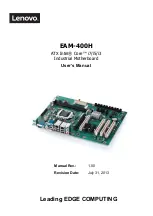
13
P6F104 User’s Manual
settings required for the memory size and type, which are
automatically detected by the BIOS.
1.8 Built-in Accelerated Graphics (AGP) Chip
The P6F104 mainboard built-in accelerated graphics chip is the
integrated Graphics Memory Controller with 64/96-bit data interface.
The 3D graphics with the texturing and visual enhancements are up to
1024x768x16bit at 85hz refresh. The 2D graphics are up to
1600x1200x8bit at 85hz refresh.
The default memory size for onboard graphic is 1M-byte. However
there is an assemble option to add up 4M-byte display cache for
graphic.
1.9 Enhanced IDE Support
The P6F104 mainboard provides two enhanced high performance
PCI IDE interfaces capable of supporting four devices with PIO
mode 0 through mode 4, bus-mastering DMA mode 2, and bus-
mastering Ultra DMA/33 or Ultra DMA/66(depend on model)
ATAPI devices. Detection of IDE device type and transfer rate is
automatically performed by the BIOS.
The traditional PIO IDE device requires a substantial amount of
CPU bandwidth to handle all the activities of IDE access including
waiting for mechanical activities. The Bus Master logic designed in
the Intel 810 Whittney chipset is intended to reduce the workload of
the CPU, hence to increase CPU efficiency. The Bus Master will
take care of the data transfer between IDE and memory and let the
CPU handle other tasks. In true multi-tasking operating systems
such as Windows 98, Windows NT, and OS/2, by using bus-
mastering IDE, the CPU workload can be reduced to complete other
tasks while disk data transfers are occurring. The driver must be
loaded in order to make the EIDE drive operate in bus-mastering
DMA mode.
Chapter 1: Introduction











































